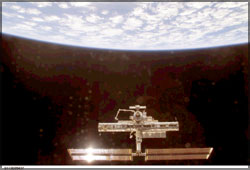What is the Kuiper Belt?
 With
all the findings in the field of space exploration, by now you must be
aware that there are many more objects in outer space than just the Sun
and the planets of the Solar System. When considering these 'other'
objects, the 'Kuiper Belt' is a region in outer space which has created
a lot of excitement in space exploration. Therefore, let's find out what
is significant about this 'Kuiper Belt'. With
all the findings in the field of space exploration, by now you must be
aware that there are many more objects in outer space than just the Sun
and the planets of the Solar System. When considering these 'other'
objects, the 'Kuiper Belt' is a region in outer space which has created
a lot of excitement in space exploration. Therefore, let's find out what
is significant about this 'Kuiper Belt'.
According to the definition, the Kuiper Belt is the region between
Neptune's orbit which lies at 30AU from the
|

What is the Kuiper Belt?
|
Sun, and 50AU from the Sun. If you are new to measurements
using AU, it is short for Astronomical Units. One Astronomical Unit is
equal to 149 598 000 kilometres.
The Kuiper Belt consists of many objects, which are not exactly
asteroids, similar to those which exist between Mars and Jupiter,
although there are some similarities as well.
The existence of this belt was suggested by astronomers Frederick C.
Leonard in 1930, and Kenneth E. Edgeworth in 1943. In 1951 Gerard Kuiper
brought in a concept which says that the belt gave birth to the short
period comets. For your information, short period comets are comets
which have an orbital period of less than 200 years.
Further studies about objects in the belt were done by Al G. W.
Cameron in 1962, Fred L. Whipple in 1964, and Julio Fernandez in 1980.
The belt was given the particular name after Kuiper, after the
discovery of (15760) 1992 QB. Apart from that, this is also called
Edgeworth-Kuiper belt to credit Edgeworth.
Have you heard of the term, 'Trans Neptunian Object' (TNO)? If not, a
TNO is generally any object that orbits the Sun at a greater distance
than Neptune, and the objects within the Kuiper Belt also fall into this
category.
|

Eris
|
Therefore, in general terms, the objects in the Kuiper Belt are
referred to as Trans Neptunian Objects.
Surely you may like to hear about some discoveries under this
subject. Although the concept was presented in 1930 and 1943, objects
from the Kuiper Belt were discovered much later. By now, over eight
hundred objects have been discovered. Every year, larger Kuiper Belt
Objects are found; objects larger than the largest asteroid in the
asteroid belt and Pluto too have been discovered.
Pluto is very special when we talk about Kuiper Belt Objects. You may
remember that since the definition of a planet was declared in August
24, 2006, Pluto is no longer considered as a planet.
In fact from the beginning, Pluto was an object from the Kuiper Belt.
But, after the discovery of Eris which is the largest Kuiper Belt object
found recently, the International Astronomical Union thought of
redefining the term 'planet' and it is important to know that Eris was
even larger than Pluto.
According to this new definition, large objects from the Kuiper Belt
cannot be considered as planets, but they can be considered as 'dwarf
planets'. When we talk about Kuiper Belt objects, a lot of scientific
terms and mathematics come in to play.
Therefore, we will just give this brief idea about the Kuiper Belt
which is an interesting region just beyond our solar system. Why not get
a hold of some sources of information and go in to more specific aspects
of these objects?
Aravinda Dassanayake
****
Two South Korean astronauts in
training
Two South Korean astronauts are undergoing a training these days,
hoping to visit the International Space Station(ISS). Although two are
in training, only one will be selected to visit the ISS. These two have
been selected from 3,600 candidates.
Imagine that! The two lucky astronauts are Lee So-yeon, aged 28, from
the Korean Academy of Science and Technology, and Ko San, aged 30, from
the Samsung research centre. This is a result of a contract between the
Russian Federal Space Agency and the South Korean Space Agency worth $20
million to $25 million.
Chinese on the moon in 15 years
China believes that they have the necessary expertise to reach the
Moon in 15 years. The success of a Moon walk is believed to depend
largely on the development of the rocket technology.
China carried out its maiden piloted space flight in October 2003,
making the country the third in the world following the former Soviet
Union and the United States to have put men into space. |
